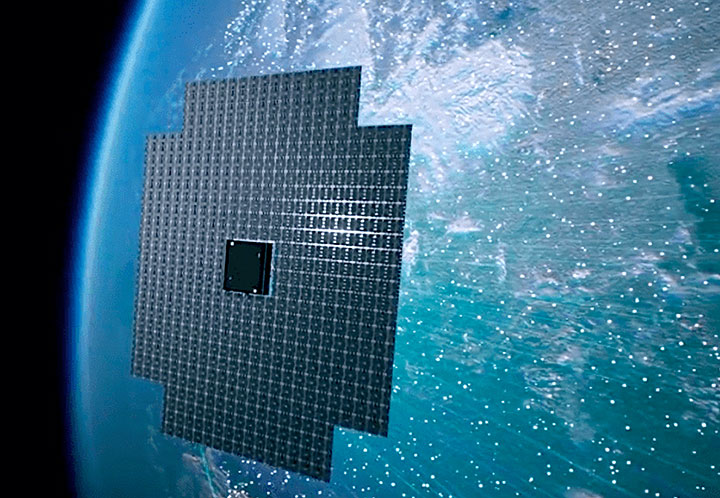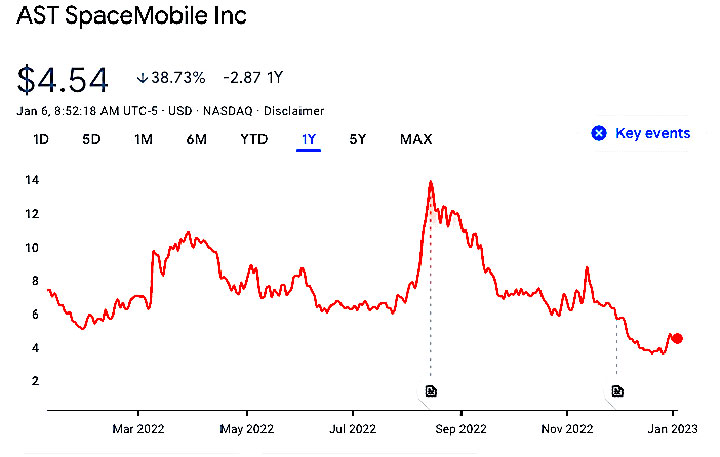 Francesco Grilli. (Source: Iridium video)
Francesco Grilli. (Source: Iridium video)
PARIS — Qualcomm’s partnership with mobile satellite service provider Iridium Communications is just the latest satellite involvement by a company that remains interested in going beyond emergency messaging to a broadband link directly from a low-orbit satellite constellation to user devices.
In short, it ultimately wants to get to a place that resembles where AST SpaceMobile plans to be in the next year or two with its Bluebird constellation designed to operate from 700 kilometers using enormous antennas to close the link to unmodified smartphones.
AST SpaceMobile says its links will offer the full 4G/5G experience to customers outside terrestrial cellular coverage using cellular network operators’ spectrum and offered as an add-on service these networks will provide.
 AST Mobile’s BlueWalker 3 satellite is schedule to begin demonstrating satellite-to-smartphone links in the coming weeks. (Source: AST SpaceMobile)
AST Mobile’s BlueWalker 3 satellite is schedule to begin demonstrating satellite-to-smartphone links in the coming weeks. (Source: AST SpaceMobile)
AST is expected to demonstrate its service in the coming months using its BlueWalker 3 satellite, already in orbit, which has received experimental operating licenses in the United States and several other nations. BlueWalker 3 is flying in an orbit of about 550 kilometers.
The company has said its Bluebird satellite constellation is waiting to be built for commercial deployment. But it still needs operating licenses and a nation willing to sign the United Nations Liability Convention and act as a guarantor of the AST constellation’s safety in orbit.
But the tide of skepticism about the business has receded considerably in recent months even as the company’s stock has suffered along with much of the tech sector and the satellite sector in the past year. In part this is due to the fact that Apple, T-Mobile, SpaceX and now Qualcomm and Iridium are developing direct-to-device links — but only for narrowband messaging.
Iridium Chief Executive Matt Desch said in announcing the Qualcomm deal for Android devices that when Iridium began engaging with Qualcomm in 2020: “I’ll be honest with you: I didn’t appreciate that this could even be done. I didn’t appreciate how far smartphone processing technology had come.
“There have been a lot of devices with sleeves to create connectivity around the smartphone. But actually embedded in a smartphone and to be able to do that quickly, effectively and smoothly through the system? We weren’t completely up to speed on that.”
 (Source: Google Finance)
(Source: Google Finance)
During a Jan. 5 briefing on what Iridium and Qualcomm will offer, starting with emergency messages later this year on Android smartphones fitted with an L-band chip to Iridium, a Qualcomm official was asked to assess an AST-type development, without naming the company directly.
“On paper, it may work,” said Francesco Grilli, Qualcomm vice president for program management and manager of satellite communications and position location technology.
“In reality, you need satellites to be in orbit and you need the licenses,” Grilli said. “Getting agreement from the regulators [to use terrestrial spectrum as a satellite service] is going to be a challenge, at least in the short term. For this particular joint project with Iridium and Garmin, we don’t need extra licenses. It’s already licensed” as Iridium spectrum in nations in which Iridium operates.
Long after it began work with Iridium in mid-2020, Qualcomm in July 2022 announced an agreement with Ericsson and Thales on a demonstration of technology that sounds like what AST is doing.
Grilli said that work continues but will require several years of work to move from R&D to operations.
“What we announced with Thales and Ericsson was a technology demonstration of the capability of doing high-data-rate through the satellite over a smartphone,” Grilli said.
“However, that approach, which is now standardized in 3GPP and NTN [the standard-setting body’s latest release including non-terrestrial networks], requires a new constellation of hundreds of satellites, and also requires spectrum. None of that has happened.”
AST, of course, would say that their network is building hundreds of satellites for high-throughput links to unmodified smartphones and is using terrestrial mobile spectrum.
“We hope to demonstrate that the technology works but it is more in the R&D phase,” Grilli said of the project with Ericsson and Thales. “It’s not handled by the Product group, which I am involved, but by the R&D group.
“This is just to show we want to push the technology further. But that effort will not see any product before 2026 at the earliest, and even that is being optimistic — assuming that the spectrum can be found and that the constellation will be available. But yes, we want to explore that capability. But it has nothing to do with this effort” with Iridium.
“This is today. This year we will be able to go commercial with existing satellites.”
Read more from Space Intel Report.
